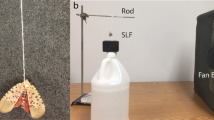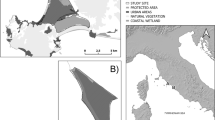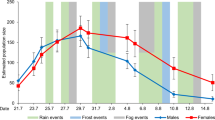Abstract
Maritime ringlet butterflies (Coenonympha nipisiquit McDunnough), an endangered species in Canada, inhabit salt marshes, which consist of microhabitat mosaics with varied larval survival rate. These microhabitats may influence the movement and reproductive behaviors of females, which in turn may affect population dynamics. I recorded behaviors and locations of females every minute with a GPS rover and calculated their move lengths and turning angles. Move lengths did not change in response to microhabitats, although turning angles became larger near bodies of water with sparse vegetation. Females spent a longer time in one location and oviposited more often where the principal larval host, Spartina patens (Aiton) Muhl., is abundant, regardless of larval survival rate. Older females tended to initiate flight more readily than younger females and spent more time flying and nectaring. Younger females were more fecund and spent a longer time at one location. Because young females tend to be less mobile and more fecund, the majority of oviposition should take place near eclosion sites. However, some eggs will be laid away from microhabitats favorable to larval survival when older females become mobile and move out of their natal microhabitats. Because it seems to have little potential to colonize new habitat on its own, monitoring population dynamics and habitat quality will be crucial for the persistence and recovery of this rare species.




Similar content being viewed by others
References
Banks CJ (1957) The behaviour of individual coccinellid larvae on plants. J Anim Behav 5:12–24
Boggs CL (1981) Nutritional and life-history determinants of resource allocation in holometabolous insects. Am Nat 117:692–709
Boggs CL (1986) Reproductive strategies of female butterflies: variation in and constraints on fecundity. Ecol Entomol 11:7–15
Capman WC, Batzli GO, Simms LE (1990) Responses of the common sooty wing skipper to patches of host plants. Ecology 71:1430–1440
Cassel A, Windig J, Nylin S, Wiklund C (2001) Effects of population size and food stress on fitness-related characters in the Scarce Heath, a rare butterfly in Western Europe. Conserv Biol 15:1667–1673
den Boer PJ (1968) Spreading of risk and stabilization of animal numbers. Acta Biotheor 18:165–194
Douwes P (1968) Host selection and host finding in the egg-laying female Cidaria albulata L. (Lep. Geometridae). Opusc Ent 33:233–279
Gillspie JH (1974) Natural selection for within-generation variance in offspring number. Genetics 76:601–608
Gossard TW, Jones RE (1977) The effects of age and weather on egg-laying in Pieris rapae L. J Appl Ecol 14:65–71
Gouge A (2002) Inventaire du Satyre fauve des Maritimes (Coenonympha tullia nipisiquit) dans la region de la baie des Chaleurs au Québec. A report submitted to Société de conservation des milieux humides du Québec, Québec. (In French.)
Gough L, Grace JB (1998) Effects of flooding, salinity and herbivory on coastal plant communities, Louisiana, United States. Oecologia 117:527–535
Haddad NM (1999) Corridor use predicted from behaviors at habitat boundaries. Am Nat 153:215–227
Hamilton WD, May RM (1977) Dispersal in stable habitats. Nature 269:578–581
Heinrich B (1986) Thermoregulation and flight activity of a satyrine, Coenonympha inornata (Lepidoptera: Satyridae). Ecology 67:593–597
Hill CJ (1989) The effect of adult diet on the biology of butterflies 2. The common crow butterfly, Euploea core corinna. Oecologia 81:258–266
Hill CJ, Pierce NE (1989) The effect of adult diet on the biology of butterflies. 1. The common imperial blue, Talmenus evagoras. Oecologia 81:249–257
Hiroki M, Obara Y, Kato Y (1998) Changes in age-related reproductive tactics in the female of the butterfly, Eurema hecabe. Naturwissenschaften 85:551–552
Jaenike J (1989) Genetic population structure of Drosophila tripunctata: patterns of variation and covariation of traits affecting resource use. Evolution 43:1467–1482
Jones RE (1977) Movement patterns and egg distribution in cabbage butterflies. J Anim Ecol 46:195–212
Jones RE, Hart JR, Bull GD (1982) Temperature, size and egg production in the cabbage butterfly, Pieris rapae L. Austral J Zool 30:223–232
Joy J, Pullin AS (1997) The effects of flooding on the survival and behaviour of overwintering large heath butterfly Coenonympha tullia larvae. Biol Conserv 82:61–66
Kareiva PM (1982) Experimental and mathematical analyses of herbivore movement: quantifying the influence of plant spacing and quality of foraging discrimination. Ecol Monogr 52:261–282
Karlsson B, Wiklund C (1984) Egg weight variation and lack of correlation between egg weight and offspring fitness in the wall brown butterfly Lasiommata megera. Oikos 43:376–385
Karlsson B, Wickman PO (1990) Increase in reproductive effort as explained by body size and resource allocation in the speckled wood butterfly, Pararge aegeria (L.). Func Ecol 4:609–617
Kemp DJ (2002) Sexual selection constrained by life history in a butterfly. Proc R Soc Lond Ser B—Biol Sci 269:1341–1345
Kimura K, Tsubaki Y (1985) Egg weight variation associated with female age in Pieris rapae crucivora Boisduval (Lepidoptera: Pieridae). Appl Ent Zool 20:500–501
Kingsolver JG (1983) Ecological significance of flight activity in Colias butterflies: implications for reproductive strategy and population structure. Ecology 64:546–551
Labine PA (1968) The population biology of the butterfly, Euphydryas editha. VIII. Oviposition and its relation to patterns of oviposition in other butterflies. Evolution 22:799–805
Leather SR (1984) The effect of adult feeding on the fecundity, weight loss and survival of the pine beauty moth, Panolis flammea (D & S). Oecologia 65:70–74
Lessios HA (1992) Testing electrophoretic data for agreement with Hardy–Weinberg expectations. Marine Biology 112:517–523
Lhonore J, Lagarde M (1999) Biogeography, ecology and conservation of Coenonympha oedippus (Fab., 1787) (Lepidoptera: Nymphalidae: Satyrinae). Ann Soc Ent Fr 35:299–307
Miller WE (1987) Spruce budworm (Lepidoptera: Tortricidae): role of adult imbibing in reproduction. Environ Ent 16:1291–1295
Miyatake T, Kawasaki K, Kohama T, Moriya S, Shimoji Y (1995) Dispersal of male sweetpotato weevils (Coleoptera: Curculionidae) in fields with or without sweet potato plants. Environ Ent 24:1167–1174
Murphy DD, Launer AE, Ehrlich PR (1983) The role of adult feeding in egg production and population dynamics of the checkerspot butterfly Euphydryas editha. Oecologia (Berlin) 56:257–263
Ng D (1988) A novel level of interactions in plant–insect systems. Nature Lond 334:611–613
Nomakuchi S, Matsumoto T, Sawada K, Sunahara T, Itakura N, Suzuki N (2001) Possible age-dependent variation in egg-loaded host selectivity of the pierid butterfly, Anthocharis scolymus (Lepidoptera: Pieridae). J Insect Behav 14:451–458
Norris MJ (1934) Contribution towards the study of insect fertility. III. Adult nutrition, fecundity, and longevity in the genus Ephestia (Lepidoptera, Phycitidae). Proc Zool Soc Lond 67:333–360
Odendaal FJ, Turchin P, Stermitz FR (1989) Influence of host–plant density and male harassment on the distribution of female Euphydryas anicia (Nymphalidae). Oecologia 78:283–288
Palmer AR, Strathmann RR (1981) Scale of dispersal in varying environments and its implications for life histories of marine invertebrates. Oecologia (Berlin) 21:1–11
Pezeshki SR, DeLaune RD (1996) Responses of Spartina alterniflora and Spartina patens to rhizosphere oxygen deficiency. Acta Oecol 17:365–378
Porter K (1992) Eggs and egg-laying. In: Dennis RLH (ed) The ecology of butterflies in Britain. Oxford Univ. Press, Oxford, U.K., pp 46–72
Root RB, Kareiva PM (1984) The search for resources by cabbage butterflies (Pieris rapae): ecological consequences and adaptive significance of Markovian movements in a patchy environment. Ecology 65:147–165
SARA Public Registry Office (2008) Species at Risk Public Registry—Maritime Ringlet. SARA Public Registry Office, Gatineau, QE. Available from http://www.sararegistry.gc.ca/species/speciesDetails_e.cfm?sid=304 [accessed 25 August 2008]
Schultz CB (1998) Dispersal behavior and its implications for reserve design in a rare Oregon butterfly. Conserv Biol 12:284–292
Schultz CB, Crone EE (2001) Edge-mediated dispersal behavior in a prairie butterfly. Ecology 82:1879–1892
Sei M, Porter AH (2003) Microhabitat-specific early-larval survival of the maritime ringlet (Coenonympha tullia nipisiquit). Anim Conserv 6:55–61
Singer MC, Ng D, Thomas CD (1988) Heritability of oviposition preference and its relationship to offspring performance within a single insect population. Evolution 42:977–985
Stern VM, Smith RF (1960) Factors affecting egg production and oviposition in populations of Colias philodice eurytheme Boisduval (Lepidoptera: Pieridae). Hilgardia 29:411–454
Strathmann RR (1974) The spread of sibling larvae of sedentary marine invertebrates. Am Nat 108:29–44
Suzuki Y (1978) Adult longevity and reproductive potential of the small cabbage white, Pieris rapae crucivora Boisduval (Lepidoptera: Pieridae). Appl Ent Zool 13:312–313
Thompson JN (1988) Evolutionary ecology of the relationship between oviposition preference and performance of offspring in phytophagous insects. Ent Exp Appl 47:3–14
Turchin P, Odendaal FJ, Rausher MD (1991) Quantifying insect movement in the field. Environ Ent 20:955–963
Via S (1986) Genetic covariance between oviposition preference and larval performance in an insect herbivore. Evolution 40:778–785
Watt WB, Chew FS, Snyder LRG, Watt AG, Rothschild DE (1977) Population structure of pierid butterflies. I. Numbers and movements of some Colias species. Oecologia 27:1–22
Webster RP (1994) Ecological studies required for a recovery and management plan for the maritime ringlet butterfly, Coenonympha inornata nipisiquit in Bathurst, New Brunswick. A report submitted to Department of Natural Resources, New Brunswick
Webster RP (1995) Ecological studies required for a recovery and management plan for the maritime ringlet butterfly, Coenonympha inornata nipisiquit in Bathurst, New Brunswick: Peters River Study, 1995. A report submitted to Department of Natural Resources, New Brunswick
Webster RP (1998) The life history of the maritime ringlet, Coenonympha tullia nipisiquit w(Satyridae). J Lepidopter Soc 52:345–355
Weissman KG (1972) The populations biology of Coenonympha tullia on Jasper Ridge: strategies of a bivoltine butterfly. Dissertation. Stanford University, Stanford, California
Wickman PO (1992) Mating systems of Coenonympha butterflies in relation to longevity. Anim Behav 44:141–148
Wiklund C (1984) Egg-laying patterns in butterflies in relation to their phenology and the visual apparency and abundance of their host plants. Oecologia 63:23–29
Wiklund C, Persson A (1983) Fecundity, egg weight variation and its relation to offspring fitness in the speckled wood butterfly, Pararge aegeria, or why don’t butterfly females lay more eggs? Oikos 40:53–63
Wilbur HM (1977) Propagule size, number, and dispersion pattern in Ambystoma and Asclepias. Am Nat 111:43–68
Zalucki MP, Kitching RL (1982) The analysis and description of movement in adult Danaus plexippus L. (Lepidoptera: Danainae). Behaviour 80:174–198
Acknowledgements
The author would like to thank G. Godin, L. Gagnon, N. D’Aoust, M. Toner, and D. Sabine of the Department of Natural Resources, New Brunswick (DNRNB), J. Gaudet of the New Brunswick Community College (NBCC) at Bathurst, and especially R. Webster, whose support and knowledge of C. nipisiquit ecology has been indispensable. B. Compton helped the author with GIS data manipulation. This manuscript greatly benefited from comments by A. H. Porter and two anonymous reviewers. The field office of DNRNB in Bathurst kindly provided the GPS rovers, the Pathfinder Office™ software, and GPS expertise. NBCC at Bathurst provided a computer and office space. This study was conducted with scientific/education permits (an unidentified permit issued in 2000, #2002-11 and #ES03-014) issued from the Species at Risk Program, Fish and Wildlife Branch, Department of Natural Resource, New Brunswick. This work was supported by DNRNB, the Joan Mosenthal De Wind Award from the Xerces Society, and University of Massachusetts Graduate Department of Organismic and Evolutionary Biology.
Author information
Authors and Affiliations
Corresponding author
Rights and permissions
About this article
Cite this article
Sei, M. Flight and Oviposition Behavior of the Adult Maritime Ringlet (Coenonympha nipisiquit McDunnough) Females in Response to Microhabitat. J Insect Behav 22, 87–100 (2009). https://doi.org/10.1007/s10905-008-9156-x
Revised:
Accepted:
Published:
Issue Date:
DOI: https://doi.org/10.1007/s10905-008-9156-x




